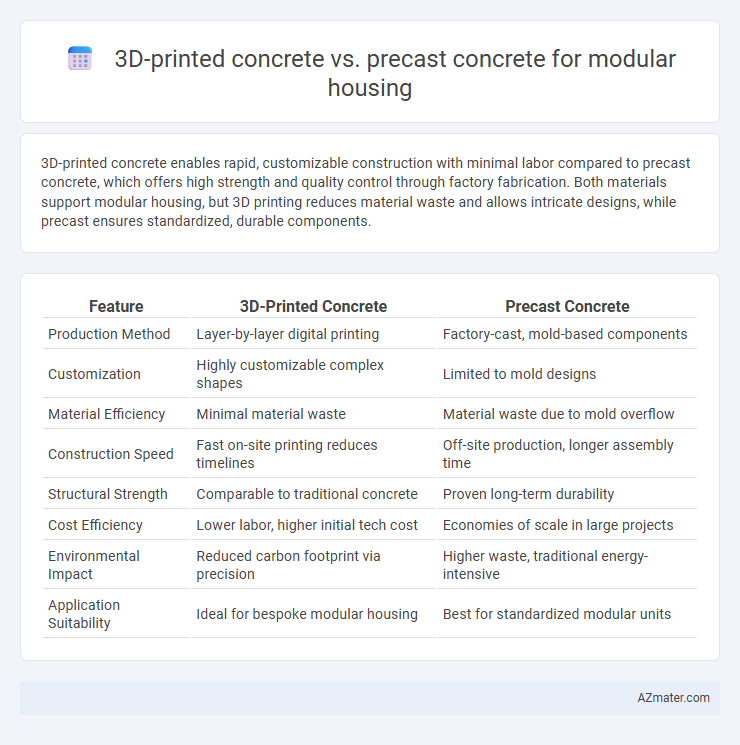3D-printed concrete enables rapid, customizable construction with minimal labor compared to precast concrete, which offers high strength and quality control through factory fabrication. Both materials support modular housing, but 3D printing reduces material waste and allows intricate designs, while precast ensures standardized, durable components.
Table of Comparison
| Feature | 3D-Printed Concrete | Precast Concrete |
|---|---|---|
| Production Method | Layer-by-layer digital printing | Factory-cast, mold-based components |
| Customization | Highly customizable complex shapes | Limited to mold designs |
| Material Efficiency | Minimal material waste | Material waste due to mold overflow |
| Construction Speed | Fast on-site printing reduces timelines | Off-site production, longer assembly time |
| Structural Strength | Comparable to traditional concrete | Proven long-term durability |
| Cost Efficiency | Lower labor, higher initial tech cost | Economies of scale in large projects |
| Environmental Impact | Reduced carbon footprint via precision | Higher waste, traditional energy-intensive |
| Application Suitability | Ideal for bespoke modular housing | Best for standardized modular units |
Introduction to Modular Housing Solutions
3D-printed concrete and precast concrete are revolutionizing modular housing solutions by offering innovative construction methods that reduce build time and costs. 3D-printed concrete enables precise, customizable designs directly on-site, minimizing material waste and labor requirements, while precast concrete provides high-quality, factory-controlled components that ensure structural integrity and faster assembly. Both technologies align with sustainable building practices and promote efficient housing scalability in urban development.
Overview of 3D-Printed Concrete Technology
3D-printed concrete technology involves layering a specially formulated concrete mix through automated extrusion to create complex structural components for modular housing, offering enhanced design flexibility and reduced material waste compared to traditional precast concrete. This method enables precise control over geometry, allowing customization at scale and faster on-site assembly due to pre-fabricated, lightweight elements. Advances in digital modeling and robotics integration further improve efficiency, making 3D-printed concrete a promising alternative to conventional precast methods in sustainable modular construction.
Understanding Precast Concrete Methods
Precast concrete methods involve casting concrete elements in controlled factory environments before transporting them to construction sites, ensuring high quality and durability through standardized curing processes. These methods allow for precise customization of modules, rapid on-site assembly, and reduced labor costs, making them a preferred choice for modular housing projects. Precast concrete components typically include walls, floors, and structural frames, which contribute to faster construction timelines compared to traditional cast-in-place concrete.
Speed of Construction: 3D-Printed vs Precast
3D-printed concrete accelerates modular housing construction by enabling on-site, layer-by-layer material deposition, reducing the need for formwork and curing times compared to precast concrete. Precast concrete components require off-site manufacturing, transportation, and assembly, which can extend project timelines despite standardized production. The on-demand fabrication of 3D-printed concrete supports rapid customization and flexible scheduling, optimizing overall speed of construction in modular building projects.
Cost Comparison and Economic Efficiency
3D-printed concrete reduces labor costs by automating the construction process, leading to savings of up to 30% compared to precast concrete, which involves manual assembly and transportation expenses. Precast concrete benefits from mass production efficiencies but incurs higher logistics and installation costs due to heavy panel handling and site preparation. Economic efficiency in modular housing favors 3D-printed concrete when projects require customization and rapid deployment, while precast concrete is more cost-effective for standardized, large-scale developments with established supply chains.
Design Flexibility and Customization Potential
3D-printed concrete offers significantly greater design flexibility and customization potential compared to precast concrete, enabling intricate geometries and complex architectural features that are difficult to achieve with traditional molds. This additive manufacturing process allows on-demand adjustments and unique form factors without skyrocketing costs, enhancing modular housing's adaptability to specific client needs. Precast concrete, while efficient for repetitive and standardized elements, is limited by mold constraints and costly modifications, reducing its ability to accommodate bespoke designs.
Structural Strength and Durability
3D-printed concrete for modular housing offers enhanced structural strength due to its ability to create complex geometries and optimized internal reinforcement patterns, resulting in uniform load distribution and reduced material stress points. Precast concrete, while traditionally known for its high compressive strength and proven durability, may face challenges in joint integrity and repetitive load resistance when modular segments are assembled onsite. Both materials exhibit excellent durability against environmental factors, but 3D-printed concrete's layer-by-layer construction allows for tailored porosity and improved crack resistance, potentially extending the lifespan of modular housing structures.
Sustainability and Environmental Impact
3D-printed concrete and precast concrete offer distinct sustainability benefits for modular housing, with 3D printing reducing material waste by precisely depositing concrete only where needed, thereby lowering carbon emissions during production. Precast concrete benefits from controlled factory conditions that enable efficient resource use and recycling of molds, though transportation to the site can increase its carbon footprint compared to on-site 3D printing. The environmental impact of 3D-printed concrete is further minimized by its potential for incorporating recycled aggregates and supplementary cementitious materials, enhancing the overall eco-efficiency of modular construction.
Challenges and Limitations of Each Method
3D-printed concrete in modular housing faces challenges such as limited material options, slower print speeds for large volumes, and difficulties achieving consistent structural strength and surface finish. Precast concrete offers faster production and high-quality control but is constrained by transportation logistics, high initial mold costs, and limited on-site customization. Both methods require advancements in curing processes and design flexibility to address scalability and integration in complex modular projects.
Future Trends in Modular Housing Construction
3D-printed concrete enables faster, more customizable modular housing production, reducing labor costs and material waste compared to precast concrete, which remains popular for its proven structural integrity and speed of assembly. Future trends indicate increasing integration of 3D printing technology with sustainable materials and smart design software, allowing for complex geometries and on-demand manufacturing tailored to site-specific needs. The convergence of 3D printing with digital twin technology and automation is set to revolutionize modular housing by enhancing precision, scalability, and environmental efficiency.

Infographic: 3D-printed concrete vs Precast concrete for Modular housing
 azmater.com
azmater.com